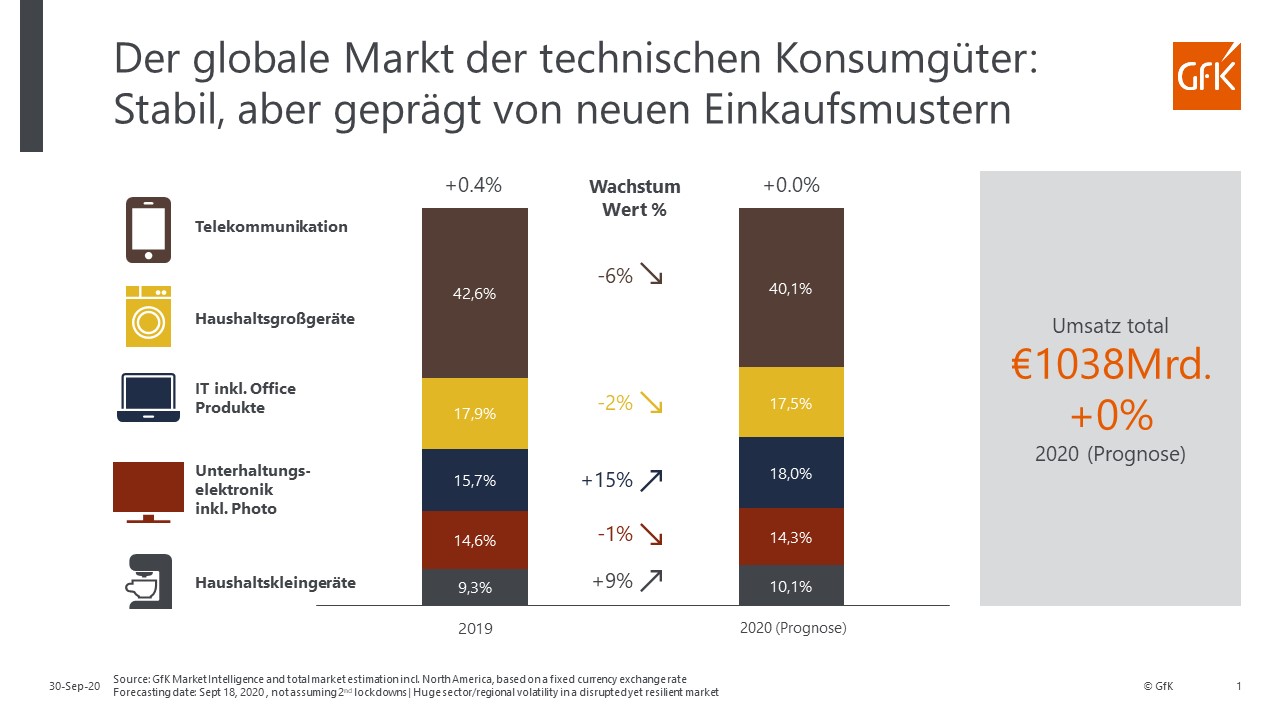GFK: Technical consumer goods defy difficult economic climate
The market for technical consumer goods TCG has experienced turbulent weeks and months. Nevertheless, Growth from Knowledge GfK predicts that the global TCG market will remain strong in terms of sales in 2020 and will remain at last year's level despite the current situation. Growth was primarily driven by consumers' strong "home" focus and the desire for greater digitization of their own living environment.

"We expect the market to continue to recover. For the last quarter of 2020, there are several indicators that point to a stable scenario for the crucial season at the end of the year," explains Luca Giuriato, GfK expert for the TCG sector. "However, market volatility will not disappear, as there have been and, in our view, will continue to be significant changes in terms of consumer demand. Sustained growth in e-commerce, in particular, will accelerate such a trend reversal. Retailers and manufacturers are now being asked to take the omnichannel experience to a new level and offer consumers what they are currently demanding."
From "want to have" to "really need"
Covid-19 had a big impact on the global TCG market. Even if it's not entirely obvious with "growth" of 0 percent compared to 2019, market volatility has never been as strong as it is this year. Proof of this is the expected 6 percent decline in the telecom/smartphone market. This market accounts for 40 percent of total TCG revenue. By contrast, the IT/office business is developing positively and is expected to grow by 15 percent.
Here, a fundamental shift occurred in the market: the "I would like" IT/office equipment became the "I need" equipment due to the lockdown and increased work from home. Somewhat later and after initial declines, demand in the small household appliances market also increased after the lockdowns and is expected to see near double-digit growth (+9 percent) in 2020. Consumer electronics (-1 percent) and large household appliances (-2 percent) are also contributing to the good development and are increasingly benefiting from trends such as "Cook@home" and "Entertain@home".
Emerging markets spend less on TCG - Europe invests
In terms of demand for technical consumer goods, there are clear differences between the various regions of the world: Industrialized countries in particular are coping better with the effects of Covid-19 than emerging economies. For example, consumers in Europe (including the CIS) spend money on technical consumer goods even in times of crisis. Here, a growth rate of 5 percent is expected for 2020 as a whole. In the emerging markets of Asia, on the other hand, a decline of 6 percent is forecast, as consumers have less money to spend due to the difficult economic situation.
Products in the area of health and well-being more in demand
Globally, demand was stronger for products that simplify our daily routine, as well as for products in the health and well-being theme worlds. In times of Covid-19, such product promises are particularly relevant for consumers, as they want to make their time at home as pleasant as possible, but also as efficient as possible. For example, the sales volume of kitchen machines in the period from May to July 2020 doubled compared with the same period last year; dishwashers, after all, increased by 16 percent. Further growth can be expected, at least in the medium term.
The focus on health and well-being has also accelerated sales of air purifiers and humidifiers (+20 percent sales growth from May to July 2020). With hygiene playing an increasingly important role in our daily lives, washing machines with a steam function to kill bacteria and viruses will also continue to sell strongly. These recorded further significant growth of 32 percent from May to July 2020 compared with the same period last year.
GfK regularly collects sales data for the consumer electronics, photographic, telecommunications, information technology, office equipment, large and small electrical appliances segments via its retail panels in more than 70 countries worldwide. All figures assume a fixed euro exchange rate.








